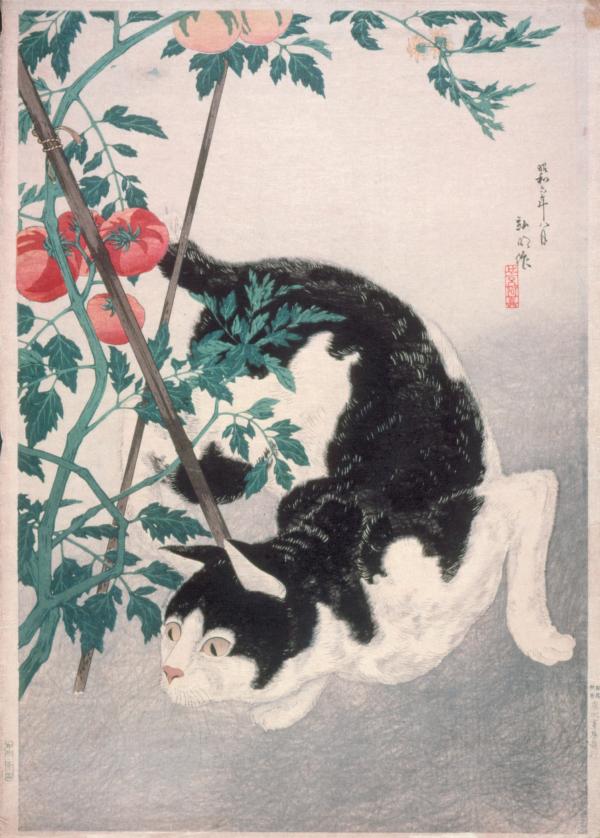The LACMA team is working together from our respective homes to bring you interesting content and creative activities while the museum is temporarily closed to the public. We may not be able to gather together, but we can still create something beautiful.
Many artists and historical figures kept journals to record ideas and observations—Frida Kahlo, Darwin, Leonardo da Vinci, Albert Einstein, Betye Saar, Lewis and Clark, Mark Twain, and Marie Curie to name a few! In a previous Make Art @ Home blog post, we showed you how to create three different types of journals using only materials that could be found around your home. Today we’re going to explore how art tells stories. So grab your custom journal—a sketchpad or any blank paper will also work—and something to write or draw with and we’ll get started!
First, let’s learn more about the artwork Cat with Tomato Plant, by artist Takahashi Hiroaki.
This particular piece of art is a woodblock print. Hiroaki carved the picture onto a woodblock, so the lines or areas to be colored were left in relief and everything else was carved away. He then put paint or ink on the wood and pressed mulberry paper on top which is strong and flexible enough to use on multiple blocks, one for each color used to create a single image. When the artist pulled the paper off, he had made a print of what he had carved on the wood. The best part? Hiroaki could make many prints off of the one woodblock carving.
Let’s take a moment to look carefully at this print.
What is the first thing you see? If you said “cat,” describe the cat. Does the cat look big, small, or medium? What colors do you see? What type of posture does the cat have? Is it sitting? Lying down? Or is it ready to pounce? What do you think the cat is looking at? Why do you think the artist chose not to show you everything? Do you think that maybe he wants you to use your imagination?
Look at the picture again.
What else do you see? Don’t the tomatoes look ripe and delicious? When do tomatoes ripen? Answer—summer! The artist is giving you more information to tell a story with the artwork. Your imagination fills in the rest of the story.
How does this artwork inspire you?
Let’s Make Our Own Art That Tells a Story!
Step 1—Draw
Make a drawing that shows the whole story of Cat with Tomato Plant—the cat and what he might be looking at. What would you add to the picture? Remember, drawing takes practice.
Step 2—Write
Write a story about what is happening. Use your imagination. Add details. Describe what the day is like. What is the cat thinking? Write the beginning, middle, and end of the story.
Step 3—Remember and Imagine
Write a short paragraph about a pet you have or had. Or maybe one you wish to have one day! Think about a funny or cute memory you have of that pet. Or an activity you would like to do with a future pet. Maybe teach it a new trick! Now draw a picture to go with what you wrote.
Step 4—Keep Journaling
A journal is like a diary where you can write or draw anything you like. Write about things you are doing, your thoughts and feelings. Write your wishes, dreams, and memories. Write funny things. Write serious things. Start stories. Finish stories. Write poems or jokes. Add pictures and memories. Collage!
Start your journal today! Just a few lines or a sketch each day. The more you create, the more you will create. Date the pages to keep track of memories or watch your skills improve. Most of all, have fun!



